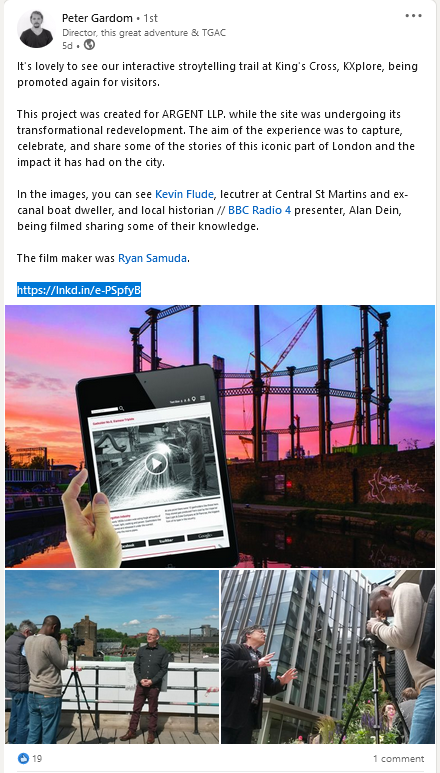
This is a project I had a small part in.
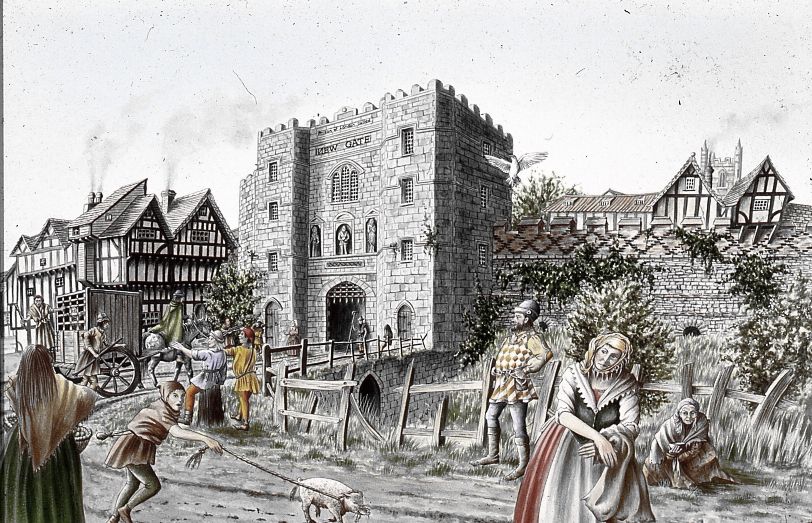
The Past brought to Life

This is a project I had a small part in.
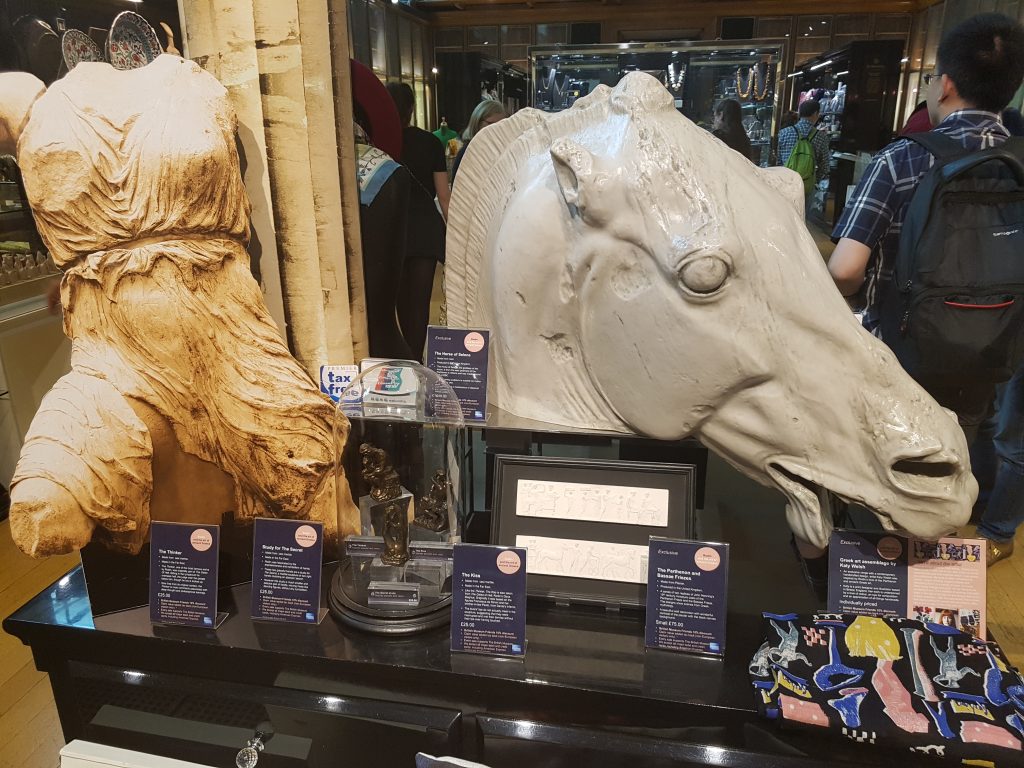
AKA the Elgin Marbles. All my life it seems as if we haven’t been talking to Greece about sending them home. Recently, there was a strong dismissal of any such hope. But today, I read that the British Museum is open to discussion. Statements from the Deputy Jonathan Williams and even the Chairman, ex Tory Chancellor of the Exchequer, George Osborne, have expressed optimism that there is a ‘deal to be done’.
Reading between the lines, the position appears to be based on the ‘fact’ that we own them legally, and that, by discussion of mutual loan arrangements, some, if not all, of the stones, can go home on loan, in exchange for other loans from Greece coming to the UK.
Nearly, all ‘restitution’ cases are settled by the realisation that there are mutual benefits to be had for the return of items. The Horniman is leading the way with its announcement to return 72 Benin Bronzes to Nigeria.
The statement from Nigeria suggests that mutual loans are a part of the deal here too.
Abba Tijani, director-general of Nigeria’s National Commission for Museums and Monuments (NCMM), said: “We very much welcome this decision by the trustees of the Horniman Museum & Gardens. Following the endorsement by the Charity Commission, we look forward to a productive discussion on loan agreements and collaborations between the NCMM and the Horniman.”
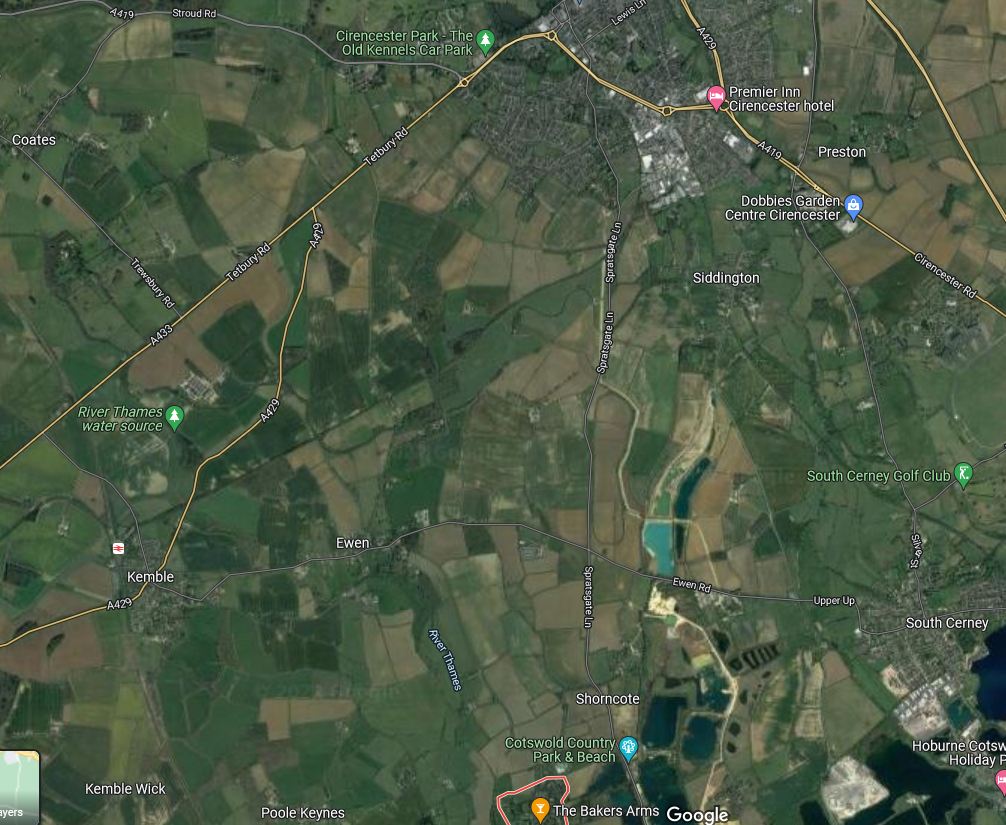
As a keen boat user of the River Thames, I am distressed to read that the source of the River Thames has ‘dried up’ for the first time. It is now five miles further down the River than it was.
The Society of Antiquities newsletter ( Salon: Issue 494) reports on a restitution deal of one of the major collections of Benin bronzes back to Nigeria.
The Bronzes, which are actually Brasses, are from the Royal Palace of the Kingdom of Benin which was looted by the British during the Benin Expedition of 1897 as part of British subjection of Nigeria.
Wikipedia reports that ‘Two hundred pieces were taken to the British Museum in London, while the rest found their way to other European museums. A large number are held by the British Museum[ with other notable collections in Germany and the United States.’
The Smithsonian has recently made a similar arrangement to restore their brasses to Nigeria, and UK collection The Great North Museum: Hancock, has followed suit joining Jesus College, Cambridge and the University of Aberdeen. (The Art Newspaper)The British Museum has refused and is indeed prevented from so doing by an Act of Parliament.
An interesting sidelight on the collection is that the wealth of the Benin Kingdom benefited from income from the slave trade.
This is what The Society of Antiquities newsletter ( Salon: Issue 494) says:
Last week, Germany signed a restitution agreement with Nigeria. The agreement covers 1,100 artefacts currently held by the Linden Museum in Stuttgart, Berlin’s Humboldt Forum, the Cologne Rautenstrauch-Joest Museum, Hamburg’s Museum of World Cultures and the State Ethnographic Collections of Saxony. The agreement immediately puts these objects into Nigerian ownership; the affected Museums will then
The Society of Antiquities newsletter ( Salon: Issue 494)negotiate directly with the Nigerian Government whether they return to Nigeria, or remain in Germany under custodial agreements.
Lai Mohammed, Nigeria’s Culture Minister, described the agreement as ‘the single largest known repatriation of artefacts in the world’. It was marked by the return of two Benin Bronzes – an eighteenth century 35kg head of an oba and a 16th-century relief depicting an oba accompanied by guards or companions. German foreign minister, Annalena Baerbock, said ‘It was wrong to take the bronzes and it was wrong to keep them. This is the beginning to right the wrongs.’
Image credits: The returned Benin Bronzes, Martin Franken
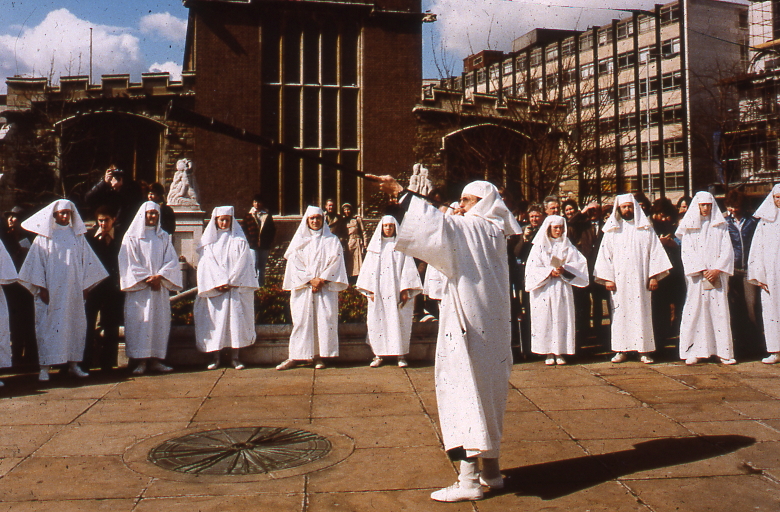
Tuesday June 21st 2022 7.30 pm Tower Hill Underground Station
(meet by the Tower Hill Tram coffee stand) |
We explore London’s History through its celebrations, festivals, calendars, almanacs and its myths and legends.
As the Sun and Moon move around our skies we look at how Londoners organised and celebrated their year throughout history.
The tour is led by Kevin Flude, a former archaeologist at the Museum of London, Curator and Lecturer
One of the most popular forms of publication in London was the Almanac. It was full of seasonal advice, of prophecy, traditional wisdom, and important events past and future. Different cultures, religions and institutions had their own methods of organisation and celebrations. We explore the varied calendars that ruled people’s lives from the prehistoric period to the present.
On the way we look at customs, and folklore of the Celts, Romans, Saxons, and into the Medieval and Modern period. We look at different calendars such as the Pagan year, the Egyptian year, the Roman, Christian, Jewish, Church and Financial years. On the route we discover the people who lived in London and walk through fascinating areas with their deep histories.
This is a London Walks Guided Walk. Look at their web site for a list of other of their amazing walks
To Book: click here
(The following is the verbatum text of the Salon IFA note on this subject. My opinion is that it sounds promising but will not happen under a Conservative Government)
Under increasing pressure from Greece and UNESCO, the British government has agreed to talks about the repatriation of the Elgin Marbles, the collection of sculptures which were taken from the Parthenon in Athens in the early 19th century by the British ambassador to the Ottoman Empire, Lord Elgin. At the time the ambassador claimed to have received a permit, since lost, to remove the sculptures from the Acropolis, which was then an Ottoman military fort. The excavation and rem oval were completed in 1812 at a personal cost to Lord Elgin, of £70,000. The marbles were bought by the British Government in 1816 for £35,000 and placed in the British Museum.
oval were completed in 1812 at a personal cost to Lord Elgin, of £70,000. The marbles were bought by the British Government in 1816 for £35,000 and placed in the British Museum.
On a visit to Britain last November, the Greek Prime Minister, Kyriakos Mitsotakis, insisted that the statues currently in the British Museum, had been ‘stolen’. Last week at a UNESCO meeting, the debate centred on whether the sculptures had been lifted from the rubble around the monument or hacked off the walls, using marble saws, as the contemporary documents seem to suggest. The Museum’s Deputy Director, Jonathan Williams FSA said the objects were not all hacked off the building. Anthony Snodgrass FSA, Honorary President of the Committee for the Reunification of the marbles, argued that the state of preservation of t

he sculptures shows the vast majority could not have fallen 40 ft to the ground but were carefully removed and had their backs sawn off.
The Greek Prime Minister has suggested that the Parthenon sculptures could be loaned to Greece in exchange for other artefacts including the golden Mask of Agamemnon. In January, Palermo’s archaeological museum returned a small fragment of the Parthenon frieze, depicting the foot of Artemis, to Athens’ new Acropolis Museum, on long-term loan. Plaster cast replicas currently stand in the Acropolis Museum, representing the statues in the British Museum.
Perhaps the resolution to this long-running dispute is, surprisingly, to be found in Apple’s latest technology. Recently, Oxford-based researchers from the Institute of Digital Archaeology (IDA), without permission – although in plain view of security – scanned 3D images of some of the sculptures using iPhones and iPads. A ‘robot sculptor’ can now create perfect replicas, using chisels and blocks of the same Pentelic marble used by the sculptor Phidias in the 5th century BC. The 3D scans were taken using a combination

of Lidar, which uses laser lights to measure distances within a fraction of a millimetre, and photogrammetry, which stitches together multiple images of a subject.
The British Museum had refused a formal application by IDA to take the 3D scans, saying it was already using 3D scanning to reveal some of the secrets of the marbles. Roger Michel, Executive Director from the Institute for Digital Archaeology (IDA) now hopes that the manufacture of incredibly-accurate replicas may pave the way for the original marbles to be returned.
I would be very interested to hear your views on the Elgin Marbles debate, and whether creating an identical copy helps or hinders finding a resolution to the issue. Please do write in to saloneditor@sal.org.uk with your views.
Image Credits: Marble relief (Block XLVII) from the North frieze of the Parthenon, British Museum, Marble relief (block XLI) from the North frieze of the Parthenon, British Museum, Scanned 3D Image, Institute for Digital Archaeology
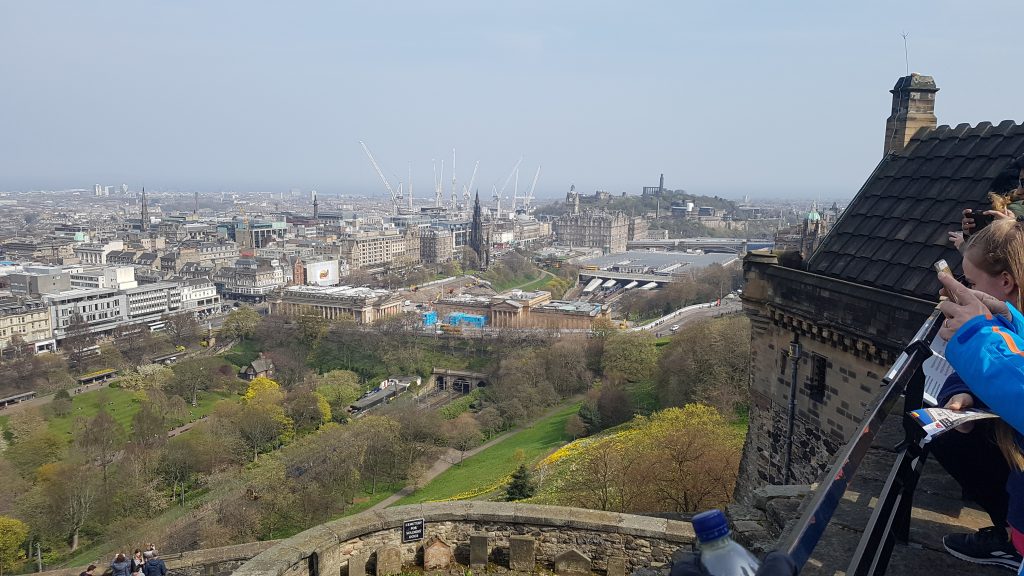
This is the Podcast for the Virtual Tour of Edinburgh
To find out or book for the Edinburgh walk and other walks this week end click here
A Virtual Tour Through The Whole Island Of Great Britain. No.5 Edinburgh
Monday 2 May 2022 7 pm
A Virtual Walk Through the Athens of the North
Borrowing my title from Daniel Defoe’s early chorography, my first Circuit is from Chester to Edinburgh. Now on the last stop on this first circuit we are taking a virtual tour of the most extraordinary City – Edinburgh.
Edinburgh is a very unusual City as it was built on the saddle of a hill so its main street runs down the ridge of a hill and the City falls away on either side. This lack of flat land and restricted space led to the City growing upwards. This gave the City an extraordinary density and an unique atmosphere that we will be exploring.
In the Georgian period the City was extended with the addition of a new town quarter which was rationally planned and made a marked contrast on the old Town. Together it gives the Capital of Scotland, a combination of atmospheric and claustrophobic town planning with the elegance of a City that was one of the great Cities of the Enlightenment.
We will begin the virtual walk in the shadow of Arthur’s Seat at the shiny new Scottish Parliament and walk up the Royal Mile from Holyrood to Tollboth, to the Netherbow and onto the Castle at the pinnacle of the City
To Book:
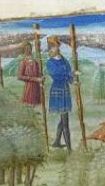
This is the Podcast for the Myths & Legends Walk this Saturday.
To find out about the three walks this Saturday click here
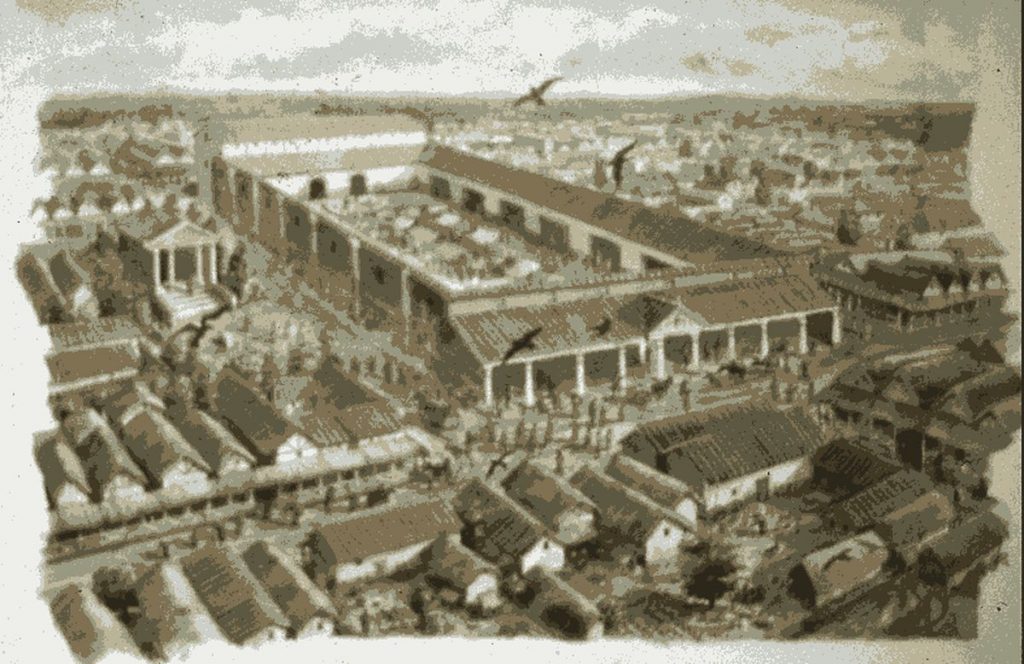
So on Saturday the 30th I am doing 2 guided walks and one Virtual Walk.
ROMAN LONDON – A LITERARY & ARCHAEOLOGICAL WALK
Saturday 30 April 20/22 11.30 am Monument Underground Station
This is a walking tour features the amazing archaeological discoveries of Roman London, and looks at life in the provincial Roman capital of Londinium.
We disembark at the Roman Waterfront by the Roman Bridge, and then explore the lives of the citizens as we walk up to the site of the Roman Town Hall, and discuss Roman politics. We proceed through the streets of Roman London, with its vivid and cosmopolitan street life via the Temple of Mithras to finish with Bread and Circus at the Roman Amphitheatre.
Publius Ovidius Naso and Marcus Valerius Martialis will be helped by Kevin Flude, former Museum of London Archaeologist, Museum Curator and Lecturer.
This is a London Walks Guided Walk
To book https://www.walks.com/our-walks/roman-london-a-literary-archaeological-virtual-tour/
Myths, Legends, May Eve London Guided Walk
Sunday 30th April 2022 2.30pm
The walk tells the story of London’s myths and legends and the Celtic Festival of Beltane.
The walk begins with the tale of London’s legendary origins in the Bronze Age by an exiled Trojan called Brutus. Stories of Bladud, Bellinus, Bran and Arthur will be interspersed with how they fit in with archaeological discoveries. As we explore the City we also look at evidence for ‘Celtic’ origins of London and how Imbolc may have been celebrated in early London.
The virtual route starts at Tower Hill, then down to the River Thames at Billingsgate, to London Bridge and Southwark Cathedral, to the Roman Forum at the top of Cornhill, into the valley of the River Walbrook, passed the Temple of Mithras, along Cheapside to the Roman Amphitheatre, and finishing up in the shadow of St Pauls
This is a London Walks Virtual Walk. Look at their web site for a list of other of their amazing walks.
To book https://www.eventbrite.co.uk/e/253596322427
This weekend I am also doing two Virtual tours
:
Myths, Legends, May Eve London Virtual Walk
Sunday 30th April 2022 7.30pm
The walk tells the story of London’s myths and legends and the Celtic Festival of Beltane
To book https://www.eventbrite.co.uk/e/myths-legends-may-day-london-virtual-walk-tickets-251923047617
And on Monday evening
A Virtual Tour Through The Whole Island Of Great Britain. No.5 Edinburgh
Monday 2 May 2022 7 pm
A Virtual Walk Through the Athens of the North
To book https://www.eventbrite.co.uk/e/256923664597
Hope to see you this weekend.
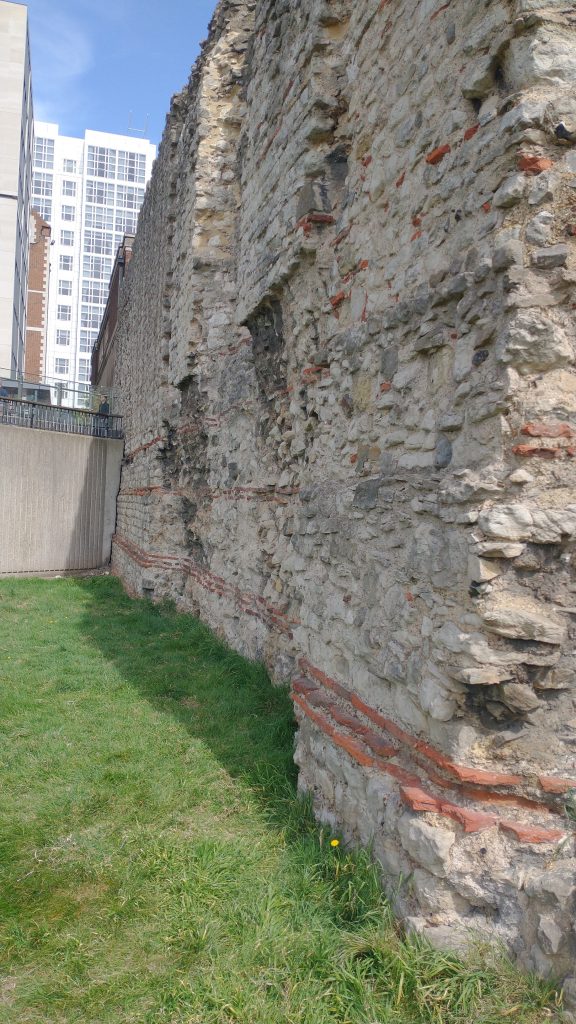
Yesterday I had a meeting with a couple of archaeologists at Tower Hill to discuss my recent letter to the London Archaeologist which suggests a piece of conservation of the wall was wrong and based on an misunderstanding of the physical remains. To my relief they agreed with my assessment of the wall and we agreed to follow it up.
It is a complex issue and I will try to upload a copy of the report at the bottom of this page. But briefly. at some point in the past the inner face of part of the wall collapsed (the piece closest to the camera). You can see that only the bottom Roman tile courses continue to the camera end of the wall – the ones above were swept away in the collapse on the inner face, they survived on the outer face.
The section just visible at the front used to show this collapse graphically because only half of the width of the tile courses survived (i.e. on the outer face not the inner face.) At some point someone in the 1980s picked up some fragments of the tile and stuck them superficially on the wall to complete the tile courses. This shows a complete lack of understanding of the archaeology of the wall and ignores the collapse. You can just see the end of that false tile course a few feet above the bottom genuine Roman tile course.
Not a great nor important bit of history but the Wall Walk plaque is wrong on this matter too so it would be good to get that changed.
Its difficult to date the original collapse but the wall at the top looks clearly medieval.
What was even more exciting is that while waiting for the archaeologists to turn up I was looking from afar at the section above. If you look very carefully at the wall nearest the camera you will see a few feet above the bottom of the wall a string of stones which are aligned to the Roman tile course and it seems that whoever recreated this section of the Roman wall after the collapse tried to copy the Roman wall but did not have any tiles so did it in stone. This part of the ‘repair’ is clearly different in style to the medieval repair above (although I had not noticed the difference in 40 years of looking at this wall).
I was very excited about this and thought maybe this is Post Roman work, because it is different to the section above which is medieval, and mimicking or continuing the Roman design the Roman. Identifying a pre-Medieval repair to the wall would be, I think, unique.
I pointed it out to Jane Sidell and Jenny Hall, and they were also interested in this finding. Jane pointed out that it seems that whoever did this seems to have been copying the Roman core of the wall just to the left, rather than copying the original Roman inner face which you can see at the end of the wall away from the camera. She thought it was more likely to have been a 19th or 20th Century repair. But we are following it up.
Here is the letter as published in London Archaeologist Vol.16 No. 2 / Autumn 2020
A longer and more extensively illustrated version is available to see here: